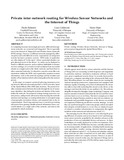- CERES Home
- →
- Cranfield Defence and Security
- →
- Staff publications (CDS)
- →
- View Item
JavaScript is disabled for your browser. Some features of this site may not work without it.
| dc.contributor.author | Palmieri, P | |
| dc.contributor.author | Calderoni, L | |
| dc.contributor.author | Maio, D | |
| dc.date.accessioned | 2017-06-20T14:23:47Z | |
| dc.date.available | 2017-06-20T14:23:47Z | |
| dc.date.issued | 2017-05 | |
| dc.identifier.citation | Palmieri P, Calderoni L, Maio D (2017), Private inter-network routing for wireless sensor networks and the Internet of Things. ACM International Conference on Computing Frontiers (CF 2017), Siena 15-17/05/2017 | en_UK |
| dc.identifier.uri | http://dspace.lib.cranfield.ac.uk/handle/1826/12072 | |
| dc.description.abstract | As computing becomes increasingly pervasive, different heterogeneous networks are connected and integrated. This is especially true in the Internet of Things (IoT) and Wireless Sensor Networks (WSN) settings. However, as different networks managed by different parties and with different security requirements are integrated, security becomes a primary concern. WSN nodes, in particular, are often deployed "in the open", where a potential attacker can gain physical access to the device. As nodes can be deployed in hostile or difficult scenarios, such as military battlefields or disaster recovery settings, it is crucial to avoid escalation from successful attacks on a single node to the whole network, and from there to other connected networks. It is therefore crucial to secure the communication within the WSN, and in particular, maintain context information, such as the network topology and the location and identity of base stations (which collect data gathered by the sensors) private. In this paper, we propose a protocol achieving anonymous routing between different interconnected IoT or WSN networks, based on the Spatial Bloom Filter (SBF) data structure. The protocol enables communications between the nodes through the use of anonymous identifiers, thus hiding the location and identity of the nodes within the network. The proposed routing strategy preserves context privacy, and prevents adversaries from learning the network structure and topology, as routing information is encrypted using a homomorphic encryption scheme, and computed only in the encrypted domain. Preserving context privacy is crucial in preventing adversaries from gaining valuable network information from a successful attacks on a single node of the network, and reduces the potential for attack escalation. | en_UK |
| dc.language.iso | en | en_UK |
| dc.publisher | ACM | en_UK |
| dc.title | Private inter-network routing for wireless sensor networks and the Internet of Things | en_UK |
| dc.type | Conference paper | en_UK |
Files in this item
This item appears in the following Collection(s)
-
Staff publications (CDS) [1216]
